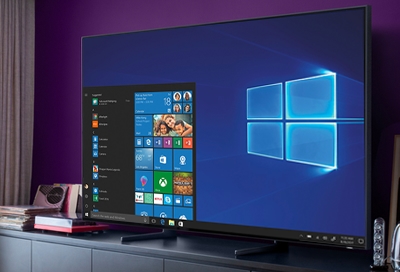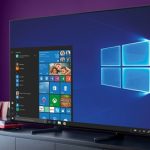Yes, you can use your TV as a computer monitor. To do so, connect via HDMI cable for optimal performance.
Using your TV as a computer monitor provides a larger screen size for a more immersive experience. Whether you’re working on spreadsheets, editing photos, or gaming, the increased display area can enhance productivity and enjoyment. Additionally, many modern TVs offer high resolution and refresh rates, making them suitable for detailed work or fast-paced games.
Before making the switch, consider the TV’s resolution, connection options, and display settings to ensure compatibility with your computer. Overall, using your TV as a monitor can be a cost-effective and versatile solution for your computing needs.

Credit: www.samsung.com
Benefits Of Using A Tv As A Computer Monitor
Using a TV as a computer monitor can offer various benefits, from enhanced visibility to a more immersive media consumption experience. Let’s explore some of the advantages of utilizing your TV screen for your computer needs.
Size And Visibility
- Larger screen size provides better viewing experience.
- Enhanced visibility for detailed work or visuals.
- Easier on the eyes due to the larger display area.
Media Consumption
- Enjoy movies and shows on a bigger screen.
- Enhanced gaming experience with more immersive visuals.
- Better collaboration in presentations or video calls.
Selecting The Right Tv For Your Computer Monitor
Looking to use your TV as a computer monitor? Making the right choice is crucial for a seamless experience. Here’s how to select the perfect TV for your computer setup:
Resolution And Refresh Rate
- Resolution: Opt for a TV with at least 1080p resolution for clear image quality.
- Refresh Rate: Choose a TV with a high refresh rate like 120Hz for smooth video playback.
Connectivity Options
- HDMI Ports: Ensure the TV has multiple HDMI ports for connecting to your computer and other devices.
- VGA or DisplayPort: Look for TVs with these ports for additional connectivity options.
- USB Ports: Having USB ports can be handy for connecting peripherals or external storage.
Connecting Your Computer To The Tv
Connecting your computer to the TV allows you to enjoy a larger screen, better audio, and a more immersive experience. Whether you want to stream movies, play games, or work on a larger display, connecting your computer to the TV is a straightforward process. There are various methods for establishing this connection, including wired and wireless options. In this section, we’ll explore the different ways you can connect your computer to the TV, highlighting both wired and wireless connections.
Wired Connections
Wired connections provide a reliable and stable way to connect your computer to the TV. There are several types of wired connections you can use, including HDMI, DVI, and DisplayPort. The most common and simplest method is through an HDMI cable, which carries both audio and video signals. Simply connect one end of the HDMI cable to your computer’s HDMI port and the other end to the TV’s HDMI port.
Wireless Connections
Wireless connections offer convenience and flexibility, allowing you to connect your computer to the TV without the need for cables. One popular wireless method is using Wi-Fi technology. Many modern TVs and computers support screen mirroring or casting over Wi-Fi, enabling you to display your computer’s screen on the TV wirelessly. Another option is to use a wireless HDMI transmitter and receiver kit, which eliminates the need for physical cables while maintaining high-quality video and audio transmission.

Credit: www.pcworld.com
Optimizing Your Tv Settings For Computer Use
Optimizing your TV settings for computer use is a great way to enhance your viewing experience. By using your TV as a computer monitor, you can enjoy a larger screen size and improved multimedia capabilities, making it easier to work or watch content on a bigger display.
Adjusting the settings for optimal use can help improve clarity and reduce eyestrain.
Display Settings
Optimizing your TV settings for computer use is essential to ensure the best possible display quality and experience. By making a few adjustments to your display settings, you can enhance the clarity, color accuracy, and overall viewing comfort while using your TV as a computer monitor. Here are some key display settings to consider:
1. Resolution
To optimize your TV’s resolution, you should set it to match the native resolution of your computer’s graphics card. This will ensure that the content appears sharp and properly scaled on your screen. To adjust the resolution, go to the display settings on your computer and select the recommended resolution for your TV.
2. Aspect Ratio
Ensuring the correct aspect ratio is important to prevent image distortion. Most modern TVs have a 16:9 aspect ratio, which is ideal for computer use. However, if your TV supports other aspect ratios, such as 4:3 or 21:9, you may need to adjust it accordingly for a proper display.
3. Overscan
Overscan is a feature commonly found in TVs where the edges of the screen are cut off. This can lead to important parts of your computer screen being hidden. To fix this, you need to disable overscan in your TV settings. Look for an option called “Just Scan,” “1:1 Pixel Mapping,” or “Pixel-by-Pixel,” and enable it to ensure that the entire computer screen is visible.
Audio Settings
Optimizing the audio settings of your TV for computer use will help you achieve clear and immersive sound quality. Here are some audio settings to consider:
1. Audio Output
If your TV has multiple audio outputs, such as HDMI, optical, or analog, you’ll need to select the appropriate output that your computer is connected to. This ensures that the audio signal is routed correctly to your TV speakers or external sound system.
2. Sound Mode
Most TVs offer different sound modes, such as Standard, Movie, Music, or Game. Experiment with these modes to find the one that suits your preferences for computer use. You may also have access to equalizer settings, allowing you to further fine-tune the audio output.
By optimizing your TV settings for computer use, you can elevate your overall viewing experience. Adjusting key display settings like resolution, aspect ratio, and overscan will ensure a crisp and properly scaled image, while optimizing audio settings such as audio output and sound mode can enhance the immersive sound quality. Take the time to fine-tune these settings, and you’ll be ready to enjoy your TV as a computer monitor to its fullest potential.
Considerations For Long-term Use
Using your TV as a computer monitor can be a convenient and cost-effective option, particularly for those who don’t have the space for a separate monitor. However, before you make this setup a permanent part of your workstation, there are a few important considerations to take into account. In this article, we will explore three key factors that need to be considered for long-term use:
Eye Strain
Sitting in front of a screen for prolonged periods of time can put strain on your eyes. This is especially true if the display is larger and you are sitting closer than you would to a traditional monitor. To minimize eye strain, there are a few steps you can take:
- Adjust the brightness and contrast settings on your TV to a comfortable level. Lowering the brightness can help reduce the glare and eye fatigue.
- Position yourself at a comfortable distance from the screen, usually around an arm’s length away. This will prevent you from having to strain your eyes to see small details.
- Take regular breaks to give your eyes a rest. Look away from the screen and focus on objects at a distance to help reduce eye strain.
Heat Management
Using your TV as a computer monitor can generate a significant amount of heat, especially if you’re using it for resource-intensive tasks or gaming. Excessive heat can not only affect the performance of your device but also reduce its lifespan. To manage heat effectively:
- Ensure that your TV has proper ventilation. Avoid blocking the vents and make sure that there is adequate space around the device for air to flow freely.
- Consider using a cooling pad or external fans to help dissipate the heat. These can be particularly beneficial if you’re using your TV for extended periods.
- Regularly clean the vents and remove any dust or debris that may be clogging them. This will help prevent overheating issues and maintain optimal performance.
Power Consumption
Another consideration when using your TV as a computer monitor is power consumption. TVs tend to consume more power compared to traditional monitors, which can result in higher energy bills. To minimize power consumption:
- Adjust the brightness and backlight settings on your TV to an optimal level. Lowering these settings not only reduces eye strain but also reduces power usage.
- Enable power-saving features on your TV, such as automatic sleep mode or eco-mode, which reduce power consumption during periods of inactivity.
- Consider using a smart power strip to plug in your TV and computer. These power strips can automatically cut off power to your devices when they are not in use, further reducing energy consumption.
By keeping these considerations in mind and taking the necessary steps to optimize your setup, using your TV as a computer monitor can be a viable long-term solution. However, it’s important to regularly evaluate your setup and make any necessary adjustments to ensure the best possible experience.

Credit: www.goodhousekeeping.com
Frequently Asked Questions Of Can I Use My Tv For A Computer Monitor
Is It Ok To Use Tv As Computer Monitor?
Yes, using a TV as a computer monitor is okay as long as it meets your needs regarding size, resolution, and connectivity.
How Can I Display My Computer On My Tv?
To display your computer on your TV, use an HDMI cable or wireless casting technology such as Chromecast or AirPlay.
Which Tv Can Be Used As Monitor?
You can use a Smart TV or a TV with HDMI input as a monitor for your computer. Check the TV’s display resolution and refresh rate before using it as a monitor.
Can I Use My Tv As A Second Monitor?
Yes, you can use your TV as a second monitor. Just connect your computer to the TV using an HDMI cable or wireless connection. Adjust settings on your computer to extend the display to the TV. Enjoy a bigger screen for work or entertainment.
Conclusion
Using your TV as a computer monitor is a convenient and versatile option. It allows for a larger screen and can be cost-effective. However, consider factors like resolution and input options to ensure a seamless experience. With the right settings and adjustments, your TV can serve as an excellent computer monitor.









